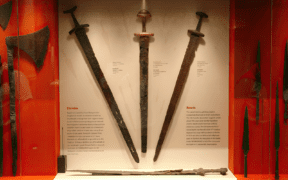Celtic Sword Types & Their Historical Uses
NO AI USED This Article has been written and edited by our team with no help of the AI

Through their swords, the ancient Celts are known for their exceptional craftsmanship, technological innovations, and advanced metalworking techniques. More than just weapons, they held ceremonial significance and served as status symbols.
This article explores the various types of Celtic swords, their features, uses, and significance in Celtic society.
Celtic Swords of the Hallstatt Period
The earliest Celtic swords were bronze and early iron swords that date back to the Hallstatt period (around 1200 – 450 BCE), which includes the Late Bronze Age and Early Iron Age in central and western Europe.
1. Gündlingen Swords

It is believed that the early Celts used Gündlingen swords mainly made of bronze and later, iron. They became widely adopted across central and western Europe. Expert J.D. Cowen suggests that these swords were a simpler, more economical version of the Mindelheim type, likely designed for foot soldiers.
Distinguishing Features
- The pommel piece—an extension of the tang designed to fit inside the pommel is typically rectangular, sometimes featuring a deep V- or U-shaped notch.
- Broad, bulging hilt and a short ricasso ( the unsharpened section of the blade located just above the guard), often with swept-back ricasso notches.
Specifications
- Overall Length: Most range from approximately 28 to 30 inches (70 to 75 centimeters).
- Blade: Long, narrow, and leaf-shaped, with a rounded central section and either rounded or V-shaped tips.
2. Mindelheim Swords

The Mindelheim sword was the first European iron sword. Compared to the Gündlingen-type swords, the Mindelheim sword was longer, more ornate, and rarer. Primarily designed as cavalry weapons, they were intended for use in combat from horseback or chariots.
Expert J.D. Cowen notes that these swords were made for slashing and were unsuitable for thrusting.
Distinguishing Features
- Unique pommel resembling a Mexican hat with a conical shape.
- Pommel is typically made from wood, bone, ivory, bronze, and iron, and some are inlaid with gold, amber, or coral.
Specifications
- Overall Length: Ranging between 32 to 36 inches (80 and 90 centimeters)
- Blade: Narrow and leaf-shaped blade with a short ricasso and sharply pointed shoulders. The tip is often clipped or features a blunt triangular or V-shape, making it unsuitable for thrusting.
3. Celtic Rapier or Knollenknaufschwert


Celtic rapiers are also known as knollenknaufschwert, meaning “bulbous tang swords” due to their hilts are from the Late Hallstatt or Early La Tène periods.
Archaeologist Radomir Pleiner suggests that these swords were likely intended for duels, fencing, and rituals rather than battlefield use, as evidenced by the many broken or intentionally deformed specimens found in rivers and lakes.
Distinguishing Features
- Bulbous tang welded with iron beads or globules—two on the guard and four at the pommel, crowning the hilt.
Specifications
- Overall Length: 34 to 42 inches (86 to 105 centimeters)
- Blade: 29 to 33 inches (73 and 83 centimeters). Slender blades with square cross-section, making them primarily suited for thrusting.
Celtic Swords of the La Tène Period
The La Tène period (450 BCE to 15 BCE) represents the Late Iron Age of the Celts. It began when the Celts first interacted with Greek and Etruscan civilizations and ended when they lost their power to Rome.
1. Celtic La Tène Long Sword


The Celtic long sword is recognizable by its guard, scabbard, suspension gear, and sometimes decorative elements. Archaeologist Radomír Pleiner stated that these swords were designed as cut-and-thrust weapons.
Distinguishing Features
- Punchmarks on the blades often feature zoomorphic designs (horses, birds, boars, bulls) and planetary symbols (crescents, solar discs). Experts believe they may represent the maker or owner, or hold symbolic, religious, or talismanic significance.
- Guards match the shape of the blade’s shoulders.
- Scabbards have engraved motifs, including zoomorphic designs, geometric patterns, spirals, triquetras, and arabesques.
- Chapes (scabbard end pieces) come in various shapes, such as open rings, medallions, and trefoils.
Specifications
- Overall Length: 42 to 52 inches (105 to 130 centimeters)
- Blade: Typically wide, double-edged, with sloping or curved shoulders.
2. Anthropoid Short Sword

Anthropoid short swords have been discovered in graves alongside chariot parts and banquet equipment, suggesting their value to aristocratic warriors. Others found in rivers and lakes suggest ceremonial use, possibly in ritual combat or challenges.
Archaeologist Barry Cunliffe proposes that these swords could have served as emblems of a particular social class. Similarly, archaeologist Radomir Pleiner suggests that, while these swords may have functioned as personal weapons for higher-ranking warriors, they were impractical in battlefield combat.
Distinguishing Features
- Hilt shaped like a human figure, forming an X to symbolize arms and legs, while the knob at the tip resembles a head, often featuring facial features. Some scholars believe that it may have had talismanic significance.
- Distinctive suspension gear and was not well-suited for combat.
Specifications
- Blade: Typically range from 12 to 22 inches (29 to 55 centimeters).
- Additional Features: Blade punchmarks and decorative scabbards resemble those found on Celtic longswords.
Conclusion
The ancient Celts used both bronze and iron swords which varied in length and design depending on their intended purpose. This diversity in sword types reflects the complexity of Celtic culture, where weaponry was not only functional but also held social and ceremonial value.





